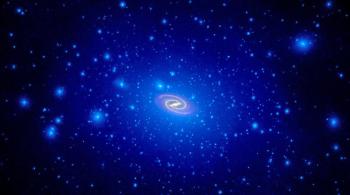
Artist simulation of dark matter halo around the Milky Way galaxy.’s own backyard. Credit: NASA, ESA, and T. Brown and J. Tumlinson (STScI)
Dark Matter
Although the existence of dark matter (DM) is strongly supported by cosmological observations, its nature is unknown.
Sterile neutrinos appear in several extensions of the SM as right-handed neutral fermions acting as singlets under the SM gauge group, not interacting but mixing with active neutrinos. A sterile neutrino with a keV mass scale could exist and account for a great part of DM. A white paper reviewing the possibility that a keV sterile neutrino might significantly contribute to the mysterious dark matter was published.
keV-sterile neutrino search in tritium beta decay experiments
If the electron neutrino contains an admixture of a neutrino mass eigenstate with a mass ms in the keV range, the different mass eigenstates will no longer form one effective neutrino mass term. In this case, due to the large mass splitting, the superposition of the β-decay spectra corresponding to the light effective mass term mlight and the heavy mass eigenstate ms, can be detectable as a distrosion of tritium the β-decay spectrum.
The signal would manifest itself as a kink-like signature and spectral distortion at E = E0 − ms, where E0 is the endpoint energy (18.575 keV). The size of the signal would be determined by the admixture sin2(Θ) of the new mass eigenstate to the electron neutrino flavor.

Statistical 90% CL exclusion limit of a 7 days differential measurement with KATRIN, as designed. Credit: T. Lasserre.
Proof-of-concept measurement in KATRIN
A measurement of the whole tritium beta-decay spectrum with KATRIN, as designed, has already the potential to improve the current laboratory limits for keV-scale sterile neutrinos. It will be performed as the first physics run of KATRIN in 2017.
In order to search for keV-scale sterile neutrinos with KATRIN the whole tritium beta decay spectrum has to be measured. Therefore the main spectrometer will be switched off, allowing all tritium beta decay electrons to reach the KATRIN 148 pixel silicon detector. Consequently, to use KATRIN as designed, the nominal electron luminosity seen by the detector must be reduced from 1010 counts per second (cps) to 105 cps .
In addition one must consider the following complications. The adiabatic transport of high-surplus electrons through the main spectrometer has to be guaranteed. The detector and rear wall backscattering needs to be mitigated and modeled to high precision. The rear wall Auger electron emission needs to be mitigated and modeled to high precision. The multiple-scattering of electrons in the gaseous tritium source (WGTS) needs to be modeled precisely
This measurement will be provide valuable information for the TRISTAN measurement with higher statistics.
The TRISTAN project: Future KATRIN upgrade to search for keV-sterile neutrinos
The TRISTAN (TRitium Investigation on STerile to Active Neutrino mixing) project aims at using the full KATRIN source strength for a keV-scale sterile neutrino search. A high statistical sensitivity can be reached, at the level of sin2θ=10-7.
Theoretical and generic experimental uncertainties have already been performed and published in JCAP 1502 (2015) no.02, 020. The technical realization of such experiment is very challenging and is currently under investigation.
Novel Detector System for the TRISTAN experiment
To make use of the full KATRIN source strength, a novel detector system is needed, based on the Silicon drift detector technology. The combination of high rates and the smallness of the sterile neutrino signature make the design of a suitable detector system a very challenging effort.
The main physics requirements are the following: 10000 to 100000 pixels with thin dead layer and low capacity, minimization of pile-up, charge sharing, few hundreds eV energy resolution, low electronics noise. a sophisticated read-out system will be needed, possibly with a full digitization of each signal waveform.
